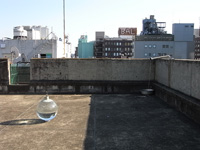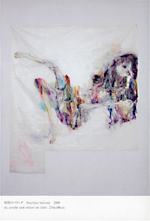 |
Picks is a monthly sampling of Japan's art scene, offering short reviews of exhibitions at museums and galleries in recent weeks, with an emphasis on contemporary art by young artists. |
 |
 |
|
|
 |
 |
|
| Tetsuya Umeda: Hajime wa Ugoiteita (At First, It Moved) |
| 2 - 24 April 2011 |
art project room ARTZONE
(Kyoto) |
 |
| Umeda is notorious for moving-object installations assembled from piles of seemingly random tools and objects. What makes them wondrous is the way that one small action causes a chain of unexpected reactions, including impressive bursts of noise and sparks, in a sort of Rube Goldberg-esque butterfly effect. ARTZONE, an experimental art space run by students at Kyoto University of Art and Design, has wisely given Umeda the use of an entire school building to let his creations run amok on a grand scale. |
|
|
 |
 |
 |
|
| Iichiro Tanaka: "Peaceful Hobby" |
| 5 March - 16 April 2011 |
Yuka Sasahara Gallery
(Tokyo) |
 |
| Multimedia artist Tanaka's latest offerings include such gems as his "Park Revolution" series of geometrically intertwined playground swings, and his "Mingei Robo" series of robotized folk-craft objects. In a show that gives full play to Tanaka's hilariously irreverent takes on the most ordinary aspects of modern Japanese life, these works are unapologetically trashy in the best sense, in that they are resolutely devoid of the slightest hint of a social message. |
|
|
|
|

|
 |
 |
 |
 |
| Hiroshi Shinno: "Live All Life" |
| 9 April - 7 May 2011 |
YOD Gallery
(Osaka) |
 |
| Out of synthetic resin and acrylic paint, Shinno constructs insects and flowers that don't exist. Inspired by the natural beauty of the mountains around his hometown (he was an avid collector of plants as a youth), Shinno's creations are utterly lifelike and biologically plausible. They also blend perfectly -- art truly mimicking life -- with the real plants he collects and arranges in seasonally appropriate combinations for his displays. |
|
|
 |
 |
 |
| Ikuyo Yamada: "Never Ever In My Life" |
|
|
Mizuma Art Gallery
(Tokyo) |
 |
| This show of new works by painter Yamada includes pastels of young girls drawn on huge sheets of tracing paper as well as an hour-long video compiled of several short pieces, all featuring the artist herself. The common thread running through the video is the artist's compulsion to display her own physical beauty on the screen, coupled with an equally strong impulse to hide. The very human conflict between self-exposure and self-concealment is an obvious concept, but no less affecting. |
|
|
|
|
|
|
|

|
 |
 |
 |
 |
| Takuma Imamura: Kids -existence- 2006-2011 |
| 12 - 21 April 2011 |
Konica Minolta Plaza
(Tokyo) |
 |
| Imamura has shot these color photos of children in a polaroid-like square format, blown up into 1x1 meter prints. Perhaps because the kids are in their own bedrooms, their expressions seem astonishingly natural. It would be more accurate, however, to describe them as expressionless. The subjects appear neither wary of the camera, nor particularly close to the photographer; indeed, it's impossible to infer any sort of emotion at all from these little poker faces. |
|
|
 |
 |
| Asuka Nakayama: empirical garden |
| 1 - 29 March 2011 |
Inax Gallery
(Tokyo) |
 |
| This solo show by Nakayama, a graduate student at Kyoto City University of Arts, consists of four large oils on canvas that fill the walls of the gallery. In works like "edible garden," she employs vivid pinks and blues to paint superficially pleasant scenes of daily life, into which she inserts jarring motifs -- chunks of meat, brassieres, and the like. Their disruption of these otherwise placid, even dull environments is almost violent. At the least, they send an involuntary shudder of disquiet through the viewer. |
|

|
 |
 |
 |
 |
|
| Takako Azami: Photosynthesis |
| 18 March - 10 April 2011 |
Art Front Gallery
(Tokyo) |
 |
| In these sumi ink works on the Japanese paper known as kumohada-mashi ("cloud-skin hemp paper"), Azami applies dots and splotches of varying sizes and densities, crisscrossing them with slender, twig-like lines. At first glance these could be figurative depictions of trees and plants, but they have more in common with abstract expressionism. Asami's process is unique: she paints on the underside of the paper, so that what we see is the ink that has seeped through to the front. Her compositions thus have a relationship to time that is the inverse of conventional paintings: her first brushstrokes appear to us on top while later ones recede to the background. |
|
|
|
|
 |
 |
 |
| Tsunehiro Takakuwa: Musicians of Islands |
| 31 March - 16 May 2011 |
Canon Gallery S
(Tokyo) |
 |
| On the southern Ryukyu islands of Okinawa, Yaeyama, and Miyako, the utasha is an entertainer who sings and dances while playing the three-stringed snakeskin lute known as the sanshin. Since 1998, Takakuwa has been shooting portraits of these artists with a 4x5 inch large-format camera. His latest exhibition features 60 prints, enlarged to B0 size, selected from photos of over 110 musicians, ranging from young lions to revered elders like Seijin Noborikawa, Misako Ohshiro, and the late Rinsuke Teruya, who passed away in 2005. |
|
|
|
|
|
|
 |
 |
| Takeshi Kainuma Exhibition |
| 7 - 30 April 2011 |
Emon Photo Gallery
(Tokyo) |
 |
| The gently rolling landscapes in Kainuma's photos seem like they might be found in Hokkaido, Japan's northernmost island and the only one blessed with much in the way of wide-open spaces. However, the locale turns out to be Kainuma's hometown, the western Tokyo suburb of Hachioji. Who knew? This also explains the show's curiously cryptic subtitle, which translates as "the place where eight kings fall asleep": Hachioji itself, for reasons lost in the mists of time, literally means "eight princes." |
|
 |
 |
 |
| Emerging Project 2011 |
| 1 - 28 April 2011 |
Yoshioka Library
(Tokyo) |
 |
| The brand-new Yoshioka Library at Shinkenchiku-sha, publisher of Shinkenchiku (New Architecture) and other architecture-related books and magazines, was designed by Akihisa Hirata as a space for showcasing the company's publications. Pleated partitions maximize the surface area, making it possible to display the covers of nearly all the magazines on the shelves. This is a particularly attractive and welcome arrangement for architecture periodicals, with which, after all, visuals are everything. This opening exhibition features models by 22 groups of young architects, including Kumiko Inui and Jo Nagasaka, interspersed among the bookshelves. |
|
|
|
|
 |
|